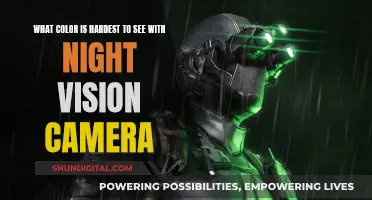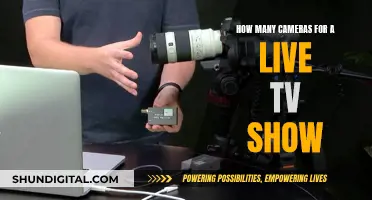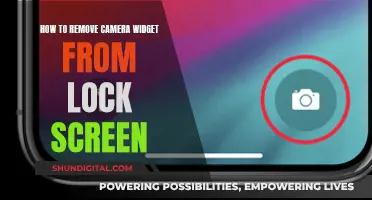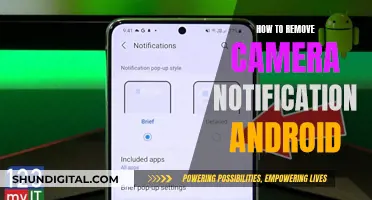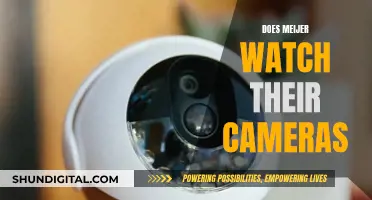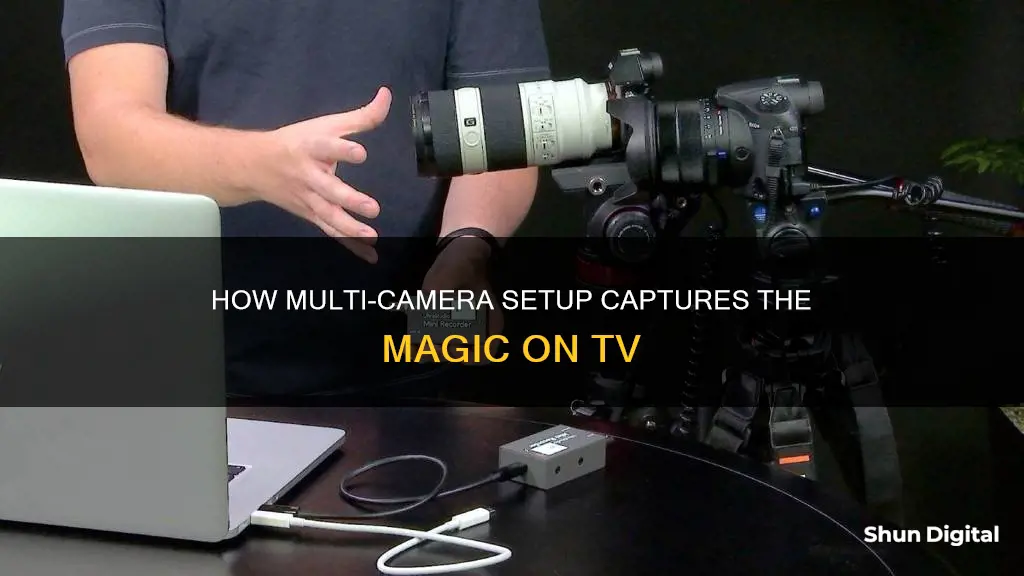
Television shows are either shot with a single-camera setup or a multiple-camera setup. In a single-camera setup, all shots and camera angles are taken using the same camera. In a multiple-camera setup, several cameras are used to capture all the different camera angles of the scene simultaneously. The multiple-camera setup is commonly used for sitcoms, soap operas, talk shows, game shows, reality television series, and sports events.
| Characteristics | Values |
|---|---|
| Number of cameras | Multiple cameras are used simultaneously |
| Camera movement | Stationary |
| Lighting | Less optimised, needs to be a compromise for all camera angles |
| Equipment placement | More complicated, e.g. microphone booms and lighting rigs |
| Recording capacity | Uses more storage space |
| Camera synchronisation | All cameras must be synchronous |
| Editing | Less time spent in post-production |
| Cost | Cheaper |
| Time | Faster to shoot and edit |
| Flexibility | Less flexible |
| Script | Requires a different script format |
| Live audience | Usually includes a live audience |
What You'll Learn

Single-camera vs. multi-camera TV shows
Single-camera and multi-camera setups are two distinct methods of filming television shows, each offering unique advantages and considerations.
The single-camera setup, also known as the portable single-camera or single-cam method, has been the standard mode of production for cinema since its development in the 1910s. In this approach, a single camera is used to capture different shots and camera angles by moving and resetting it for each new angle. This allows for greater control over each shot by the director but is more time-consuming. Single-camera is often chosen for prime-time dramas, made-for-TV movies, music videos, and advertisements. It is also preferred when specific camera angles, movements, and visual effects are crucial to the production's success.
On the other hand, the multi-camera setup employs multiple cameras to capture various camera angles of a scene simultaneously. This method is generally faster and more cost-effective, making it ideal for soap operas, talk shows, game shows, reality TV series, and sitcoms. Multi-camera is the only way to record an ensemble of actors performing before a live audience from multiple perspectives.
The multi-camera setup is often used for light entertainment, sports events, news coverage, sitcoms, and shows with a live audience. It gives the director less control over individual shots but offers efficiency in terms of time and cost. The multiple cameras capture different shots of the live action as it unfolds, and the director creates a line cut by instructing the technical director to switch between the camera feeds.
Single-camera sitcoms have gained popularity in recent years, with shows like "Modern Family", "Silicon Valley", and "The Last Man on Earth" as examples. These shows are shot more like films, without a live audience, resulting in a different style of humour compared to multi-camera sitcoms.
Multi-camera sitcoms represent the traditional approach to television comedy, with classic examples including "The Dick Van Dyke Show", "The Mary Tyler Moore Show", and "Friends". The setup involves a live studio audience, giving the show a similar feel to live theatre. The scripts for multi-camera sitcoms are also formatted differently, with a more technical approach to accommodate the live audience and faster production pace.
Best Platforms to Watch Frights Camera Action
You may want to see also

Advantages of multi-camera production
Multi-camera production is a method of filmmaking, television production, and video production that offers several advantages over single-camera setups. Here are some benefits of using multiple cameras:
Enhanced Viewer Experience:
Multi-camera filming engages and captivates audiences by offering a variety of shots and perspectives. The ability to cut between wide shots and close-ups adds depth to the story and prevents scenes from becoming stagnant. This dynamic approach to filming elevates the viewing experience, especially for live events, by ensuring that no detail is missed.
Efficiency in Production:
One of the significant advantages of multi-camera production is the efficiency it brings to the filming process. With multiple cameras capturing different angles simultaneously, there is no need to reset and relight the scene for each shot, reducing the time spent on filming and editing. This makes it ideal for high-output shows with quick turnaround times, such as daily soap operas, or live events where the action unfolds chronologically.
Creative Freedom and Flexibility:
Shooting with multiple cameras provides greater creative freedom to capture spontaneous moments, such as improvisational scenes or reality show interactions. It allows filmmakers to react to unexpected events and ensure that they capture all the action from multiple perspectives. This flexibility in capturing content translates into more options during the editing process, enabling editors to craft cohesive and creative narratives.
Simplified Continuity and Synchronization:
Multi-camera production simplifies the challenge of tracking continuity issues. With multiple shots obtained in a single take, there is less risk of inconsistencies when compared to reshooting scenes from different angles. Additionally, synchronizing multiple cameras using techniques like SMPTE timecode and Genlock ensures that all cameras and audio sources are in sync, streamlining the editing process and enhancing the overall production workflow.
UHD TV Camera Privacy: LG's Secret Feature?
You may want to see also

Multi-camera sitcoms
In a multi-camera sitcom, the two outer cameras typically capture close-up shots of the two most active characters, while the central camera(s) capture a wider master shot to provide context and establish the geography of the room. This approach offers several advantages, such as obtaining multiple shots in a single take without interrupting the flow of the scene. It also reduces the time spent on lighting and setting up different camera angles, making it a more efficient and cost-effective option.
While multi-camera sitcoms were more common in the past, there has been a resurgence in single-camera sitcoms in recent years, with shows like Modern Family, Silicon Valley, and The Last Man on Earth opting for this format. Despite this shift, multi-camera sitcoms remain a beloved and enduring format in television comedy, with shows like The Big Bang Theory carrying on the tradition.
Controlling Your Camera with Apple Watch: The Ultimate Guide
You may want to see also

Single-camera sitcoms
In television production, both single-camera and multiple-camera methods are used. Single-camera sitcoms are often notable for their enhanced visual style, use of real-world filming locations, and, in recent years, the absence of a laugh track. The single-camera setup is more time-consuming but gives the director more control over each shot. It is mostly reserved for prime-time dramas, made-for-TV movies, music videos, and commercial advertisements.
Some examples of single-camera sitcoms include *The Adventures of Ozzie and Harriet*, *Leave It to Beaver*, *The Andy Griffith Show*, *The Addams Family*, *The Munsters*, *Get Smart*, *Bewitched*, *I Dream of Jeannie*, *Gilligan's Island*, *Hogan's Heroes*, and *The Brady Bunch*. More recent examples include *Malcolm in the Middle*, *Curb Your Enthusiasm*, *Arrested Development*, *The Office*, *It's Always Sunny in Philadelphia*, *Community*, *Parks and Recreation*, and *Modern Family*.
Pinhole Camera Eclipse Viewing: A Safe, Easy Guide
You may want to see also

The history of multi-camera TV
The use of multiple cameras in television has a long history, dating back to the early days of the medium. The multiple-camera setup, also known as multicam, is a method of filmmaking and television production where several cameras are employed to capture different angles of a scene simultaneously. This technique has been an essential part of live television, giving directors the ability to capture different shots of a live situation as the action unfolds.
The use of multiple film cameras can be traced back to the development of narrative silent films, with the earliest known example being the first Russian feature film, "Defence of Sevastopol" in 1911. However, the adoption of multicams for television has a more recent history. The first drama broadcast on television, "The Queen's Messenger" in 1928, utilised three cameras to capture the performance. This marked the beginning of multiple-camera usage in television, which soon became a standard technique for live shows.
In the following decades, the multiple-camera setup became increasingly popular for television productions. By the 1950s, it was the norm for US sitcoms, with shows like "I Love Lucy" and "The Dick Van Dyke Show" embracing the format. The multicam approach allowed for efficient filming, reducing the time spent on editing and setup. It also enabled the capture of multiple shots in a single take, making it ideal for shows with high output demands, such as daily soap operas.
In the 1960s, however, there was a shift towards single-camera usage in US sitcoms. Shows like "Leave It to Beaver" and "The Brady Bunch" utilised single-camera techniques to achieve more complex visual effects and larger casts. This trend continued into the early 1970s, with shows like "M*A*S*H" and the early seasons of "Happy Days" opting for the single-camera approach.
It wasn't until the latter part of the 1970s that the multiple-camera setup made a strong comeback in US sitcoms. The success of shows like "All in the Family", which was taped with multiple cameras in front of a live studio audience, renewed producers' interest in the multicam format. By the 1980s and 1990s, the multiple-camera approach once again dominated the sitcom landscape.
In recent years, there has been a resurgence of the single-camera format in sitcoms, with shows like "Modern Family", "Curb Your Enthusiasm", and "The Office" opting for this style. This shift has been attributed to the desire for more complex camera angles, visual effects, and a film-like aesthetic. Nonetheless, the multiple-camera setup remains prevalent in certain genres, including soap operas, talk shows, game shows, and sitcoms with live studio audiences.
Apple Watch Ultra: Camera in the Crown?
You may want to see also
Frequently asked questions
A multi-camera TV show is one that is shot with multiple cameras capturing different angles of the scene simultaneously.
Shooting with multiple cameras is faster and cheaper than single-camera setups. It also reduces the complexity of tracking continuity issues and the time spent editing.
A multi-camera setup has less optimised lighting and less flexibility in putting the necessary equipment on scene. It also uses more recording capacity.
Some famous multi-camera sitcoms include Seinfeld, Friends, Two and a Half Men, and Fresh Prince of Bel-Air.
Some examples of single-camera sitcoms are The Office, Modern Family, and Superstore.



